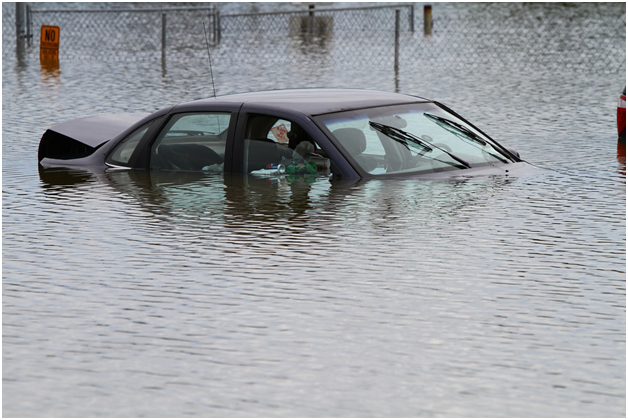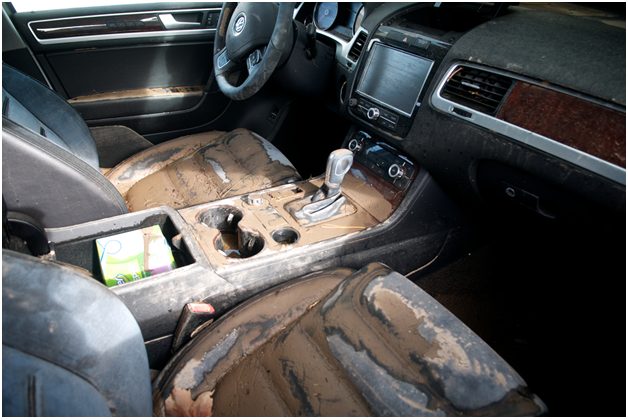An Ultimate Guide To Things To Do In Case Your Car Gets Flooded
By Andrea Nicole
Posted on Oct 20, 2022

Wherever you are, if Mother Nature decides to surprise us with the deadliest weather, there’s nothing that we can do. Although the actual calamity is unavoidable, it is essential to familiarize yourself with the aftermaths of it. One of the problems that most people face during this time is destroyed cars due to flooding. Here’s a quick guide on how you should go about should you encounter this problem.

Source: Flickr
What happens to your car once flooded?

Source: Picryl
Before we go into the step-by-step process of how to respond to your flooded car, let us first discuss the issues you’ll encounter with your vehicle after a downpour.
- Electrical System Malfunction: The electronics of your car are one of the most severe damages from flooding. The primary reason for facing these problems is short circuits. This comes from the build-up of moisture from the temperature brought about by the storm. Should you notice something wrong with your electrical control unit (ECU), fuses, audio systems, air conditioning system, and other components, then there is probably electrical trouble.
- Interior Molds: There are also times when flooded cars cause health issues to people. Whenever it gets submerged in water, there is a high chance that there will be mold and mildew build up in your interiors. These are usually found in seats, door panels, trunks, carpets, floor mats, and headliners. If left unnoticed, it may only cause respiratory diseases to the driver and passengers.
- Engine Mechanical Damages: Engines are one of the most critical components to check after flooding. When water extends to the engine parts, such as the cylinders and air intake, compression will happen to the piston. Given that water does not compress, there is a high possibility that the engine will stall since the piston's rods will break.
- Corrosion in Car Parts: One of the most common problems a vehicle encounters when exposed to flood is developing rust. It might take a long time for rust to form in the different parts of your car. However, once it spreads out, it may only weaken the structure of the vehicle. This may lead to the deterioration and lessened functionality of vital parts like shifting gears and brakes.
- Contaminated Fluids: Trouble is just around the corner when water contaminates your vehicle’s fluids such as the brake fluid, coolant reservoirs, transmission, and power steering. These are even more critical when floodwater integrates with spark plugs, fuel, and fuel injectors.
Things To Do If Your Car Gets Flooded
Don’t panic once you see your vehicle submerged in a pool of water. There are a lot of things that you can do to avoid aftermath damages without having to spend a lot of money. Listed below is a quick guide that you can use for reference.
Check and Survey The Situation
When you see the state of your car, don’t be distracted by panic and surprise. Instead, make sure to survey the situation first and check how much damage your car has encountered. Do not forget to support this by taking photos of the initial situation since it might get useful along the way especially when you’re applying for insurance.
Always remember not to start the engine instantly. It might be detrimental to the situation of the car if you still don’t know the actual state it is in. Just in case it houses water inside upon starting, there is a high chance that it will result in a hydrolock. This not only hurts your vehicle but might also create a hole in the pocket due to the enormous repair bill you’ll face.
Dry Your Car
The next thing you should do is dry your vehicle. Remove as much moisture as you can to avoid any musty odor or the growth of mold.
The best way to eliminate moisture from your vehicle is through the use of a vacuum. A vacuum has different tips and noses that you can use but make sure to maximize the smaller ones so that you get to sweep up to the corners. It can also be helpful to use towels to help dry big pools of water.
Just to end the process, you can completely dry the car with the use of fans to help dry the seats and cushions. Open all the doors and just allow the air to flow in the car. This won’t only dry the car but also eliminate all the lingering odors and avoid mold and mildew.
File Your Claim

Source: Pix4free
It is recommended to have car auto insurance so you’re secured during these trying times. These comprehensive auto insurances will shoulder the expenses for repair or even pay for your vehicle if it’s completely totaled.
With this in mind, always put this step as a critical item on your list. Call your insurance agent and inform them of the situation so they can advise you on the next steps. Repairs under this insurance fall under the Acts of Nature coverage. It’s better if you send them a photo of the condition of your vehicle and even create a testimony of what happened to keep you covered.
Thoroughly read your insurance coverage and make modifications if you see any holes and opportunities in your policy.
Check the Fuel and Electrical System
Another crucial thing at times like this is to check the oil level. Get a stick and measure the oil in your vehicle. You’ll get a view of whether there are droplets on the sticks, and this usually means that water has entered the engine. Make sure that you do not start your car to avoid the mixture of oil and water. The next thing to do is to secure the fuel system to drain the gas and flush it out.
There’s also merit to inspect the electric system and determine whether they are placed above or below the flood level. If below, it is crucial to replace the affected system. Don’t forget to keep the following in check as well: power locks, headlights, power windows, turn signals, clutch, brakes, coolant reservoirs, clutch, and power steering.
Call a Qualified Mechanic

Source: Pexels
If there is severe damage experienced, it’s better to call a mechanic to inspect the totality of the situation. This can also be the time to get a quotation on how much the repair would be.
Weigh the Options
Now that you have a view of how much everything would cost, net out the expenses that your insurance will cover, if any. Once you have crunched the final number, compare it to the value if you were to buy a new car. If repairing your current car is more costly, then it might be better to start window shopping for another vehicle.
Save Your Flooded Car
The main question is whether there’s a chance to save your precious vehicle after encountering a flood. There are various factors to consider. If you’re living near a coastal area, then your car might only be integrated with salty water. If this scenario holds you, don’t even bother to save it, as this is beyond repair already.
If it’s fresh water, however, then an experienced mechanic will be your friend. Make sure that you get to partner with someone who already has experience with fixing flooded cars.
Overall, it’s not too late if you’re dealing with fresh water damage. Just follow the tips above to help you with this car dilemma.


